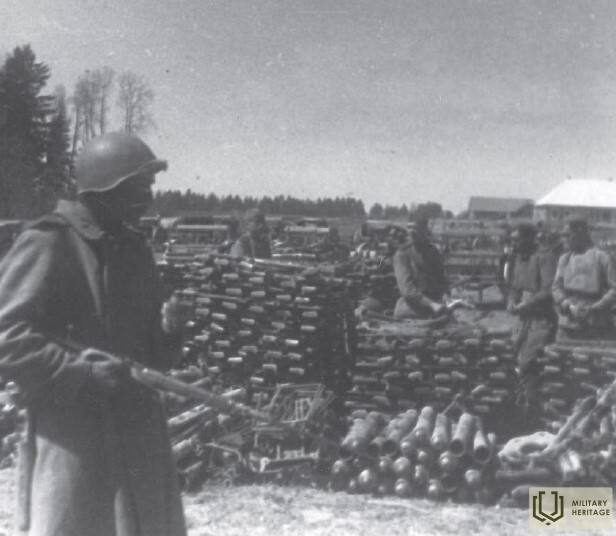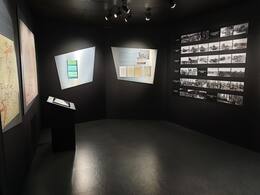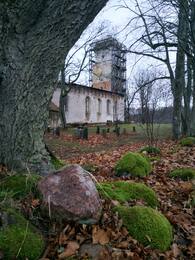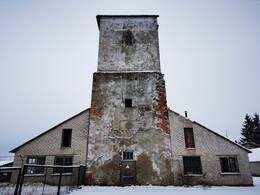Die Erinnerungen von Jānis Miesnieks aus Ezere über das Ende des Zweiten Weltkriegs in Ezere
In einem historisch bedeutsamen Gebäude wurde das Depot für kulturgeschichtliche und regionale Forschungsmaterialien des Sees „Muitas nams“ eingerichtet. Am 8. Mai 1945 wurde hier die Kapitulationsurkunde der an der Kurischen Front eingeschlossenen Einheiten der nationalsozialistischen deutschen Armee unterzeichnet.
Jānis Miesnieks (geb. 1930), ein ehemaliger Einwohner von Ezer, teilt seine Erinnerungen an die Ereignisse dieses Tages.
Der Frühling 1945 kam und die Frontlinie war bereits in der Nähe von Saldus. Auch alle Nachbarn sind von der Zwangsevakuierung in Litauen zurückgekehrt. Durch den Zufall des Schicksals wurde ich Zeuge eines wichtigen historischen Ereignisses. Eines Tages im Mai kam ein Typ aus Mažeikikai, um die Bezahlung für die im Sommer geleistete Arbeit entgegenzunehmen. Die entsprechenden Getreidesäcke schleppten wir in den Pferdewagen, der von der alten, sehr erfahrenen Stute Irma gezogen wurde. Die Bewegung konnte nur entlang der sehr schmalen Seite der Autobahn stattfinden, weil in der Mitte eine tiefe, hohle Furche war, die von schweren Maschinen ausgetrieben wurde. Es war bereits Nachmittag, als wir „Zakai“ nach Ezeri verließen. Das Tempo, mit dem wir uns fortbewegten, mag etwa 3 km/h betragen haben. Die Straßenpatrouille der Armee ließ uns jedoch nicht über die Vadakste-Brücke nach Mazeikikai in Ezere. Die nächste Brücke über den Vadakste war in der Nähe von Laižuva, und statt 13 km wurde die Straße zum Ziel 33 km lang. Nachdem wir einige Kilometer gefahren waren, fuhren mehrere exzellente schwarze Limousinen wie Phantome aus einer anderen Dimension langsam entlang dieser zerstörten Straße auf uns zu. Man konnte deutlich die Leute in der Kajüte sehen – hochrangige Kommandeure der Roten Armee und ganz hinten einen deutschen Offizier mit charakteristischen hohen Uniformhüten. Unterwegs hörten wir auch recht laute Geräusche von vorne. Aber als die Nacht hereinbrach, brannte der gesamte Rand der Front mit einem Feuer, einer Salve von Raketen, die Spuren leuchtender Kugeln zierten den Rand des Himmels wie Perlenschnüre. Schön, wenn auch nur ohne Blutpreis. Es war offensichtlich, dass das Inferno in meiner Kurzemīte zu kochen begonnen hatte... Je dunkler es wurde, desto intensiver erleuchtete das Feuer von vorne die Außenbezirke.
Wir erreichten Mazeikis bei Sonnenaufgang. Es stellt sich heraus, dass ein bescheidenes Landhaus der Endpunkt unseres langen, ausgetretenen Weges war, der mit beträchtlicher Anstrengung zurückgelegt und mit spannenden Ereignissen gefüllt war. Hier wurde die Fracht entladen und erhielt, wie es schien, eine verblüffende Nachricht: Der Krieg ist vorbei!!! Gestern, am 8. Mai, unterzeichneten die Deutschen in Ezere die Kapitulation.
Mit dem leeren Karren ging es sofort durch den See nach Hause, vor Erschöpfung dösend. In weniger als einem Tag hatte sich die Lage in der Welt radikal verändert: Als ich gestern von zu Hause wegging, herrschte noch Kriegszustand, aber bereits am Morgen des 9. Mai herrschte Frieden. Im See hinter der Vadakste-Brücke kam ich an einem ehemaligen Zollhaus vorbei, wo gestern die bevollmächtigten Vertreter der Wehrmacht den Akt der bedingungslosen Kapitulation der Armeen der kurländischen Einkreisungsfront unterzeichnet hatten. Aus diesem Grund wurde gestern die Straße über die Brücke gesperrt und das Schicksal gab mir die Gelegenheit, die an der Veranstaltung beteiligten Teilnehmer und die Woge der Emotionen in der ersten Friedensnacht an der Front zu sehen. Damit hatte der höllische Kessel im Kessel von Kurzeme aufgehört zu kochen. Als ich am Morgen des 9. Mai nach "Zaķi" zurückkehrte, waren die Verbindungsoffiziere der Armee, die in unserem Haus wohnten, in völliger Raserei ...
Zugehörige Zeitleiste
Zugehörige Objekte
Zollhaus Ezere - Sammlung kulturhistorischer und heimatkundlicher Zeitzeugnisse
Das Zollhaus Ezere liegt unweit der Landstraße Saldus-Mažeikiai an der lettisch-litauischen Grenze. Am 8. Mai 1945 wurde in diesem Gebäude von den Befehlshabern der im Kurland-Kessel eingeschlossenen deutschen Heeresgruppe Kurland die Kapitulationsurkunde unterzeichnet. Daher kann man das Ende des Zweiten Weltkrieges in Ezere verorten. Die Ausstellung im alten Zollhaus informiert über die Ereignisse am Ende des Zweiten Weltkrieges sowie über die historische Entwicklung der Umgebung von Ezere von der Vor- und Frühgeschichte bis in unsere Tage. Am Morgen des 7. Mai 1945 stellte der Befehlshaber der Leningrader Front, Marschall L. Goworow, ein Ultimatum an die Befehlshaber der Heeresgruppe Kurland und forderte sie auf, die Waffen niederzulegen. Die Kapitulationsakte wurde am 8. Mai von beiden Seiten unterzeichnet und das weitere Vorgehen vereinbart: die Orte der Waffenübergabe, der Umfang der vorzulegenden Dokumente und Informationen sowie weitere Maßnahmen praktischer Natur.
Filtrationslager für Gefangene der Roten Armee in Grieze und die Kirche von Grieze
Grieze liegt an der lettisch-litauischen Grenze, wo der Fluss Vadakste in den Fluss Venta mündet. Die Kirche von Grieze wurde 1580 erbaut, aber die Gemeinde bestand schon vor 1567. Die Kirche wurde mehrmals umgebaut - 1769, 1845 und 1773 wurde die erste Orgel eingebaut. Sowohl das Altarbild als auch die beiden Glocken sind aus verschiedenen Gründen verloren gegangen.
Im Garten der Kirche befindet sich ein Friedhof, auf dem Angehörige der Kirche und Adelige begraben sind. Einer von ihnen ist der Griezer Organist Friedrich Baris und seine Frau Charlotte, denen ein Denkmal vor der Sakristei der Kirche gesetzt wurde. An der Südseite der Kirche sind 32 schwedische Soldaten begraben, die im Großen Nordischen Krieg gefallen sind. Auf dem Friedhof befinden sich auch die Gräber von 110 deutschen Soldaten, die im Ersten Weltkrieg gefallen sind und für die 1930 ein Denkmal errichtet wurde.
Während des Zweiten Weltkriegs wurde die Kirche in Mitleidenschaft gezogen, als Ende Oktober 1944 die Frontlinie entlang des Venta-Flusses verlängert wurde und die 225. deutsche Infanteriedivision in der Nähe der Kirche von Grieze stationiert war. Als die sowjetische 4. Stoßarmee am 19. November 1944 Angriffe über den Venta-Fluss startete, schlugen mehrere Artilleriegranaten in die Südwand der Kirche ein und der Kirchturm wurde schwer beschädigt.
Nach der Kapitulation der Heeresgruppe Kurzeme wurden an der Leningrader Front der Roten Armee 284 171 Menschen gefangen genommen. 7493 waren Soldaten der Roten Armee, die aus deutscher Gefangenschaft entlassen wurden. 48 deutsche Generäle ergaben sich in die Gefangenschaft. Nach den Unterlagen, die bei der Kapitulation der Heeresgruppe Kurzeme vorgelegt wurden, belief sich die Zahl der Soldaten auf etwa 185 000. Der Rest der fast 100 000 Personen, die der Filtration unterworfen wurden, waren Kurzeme-Zivilisten und sowjetische Flüchtlinge, da die sowjetische Leningrader Front am 10. Mai 1945 anordnete, alle Männer zwischen 16 und 60 Jahren der Filtration zu unterwerfen.
Im Gegensatz zu den Streitkräften anderer Länder wurden in der Roten Armee die Kontrolle, die Bewachung, die Pflege und der Schutz der Kriegsgefangenen nicht von den Armeeeinheiten, sondern von den Organen für innere Angelegenheiten - dem Volkskommissariat für Staatssicherheit - durchgeführt. Die Hauptaufgabe der Filterung bestand darin, Bürger der UdSSR und der von der Sowjetunion besetzten Länder aufzuspüren, die auf deutscher Seite an den Feindseligkeiten teilgenommen hatten. Gefangene deutsche Soldaten wurden untersucht, um mögliche Kriegsverbrecher zu ermitteln.
In der Nähe der Kirche von Grieze befand sich vom 10. Mai bis zum 17. Juni 1945 ein Filtrationslager für Kriegsgefangene. Das Lager befand sich wahrscheinlich hier, weil die Kirche von Grieze in der Nähe der Hauptverkehrsstraßen lag. Die Gruben im Boden, in denen sich die Häftlinge in kalten Nächten vor der Kälte versteckten, indem sie sich mit allem Möglichen zudeckten, sind in der Umgebung noch gut zu erkennen. Während dieser Zeit verursachte die Rote Armee erhebliche Schäden im Inneren der Kirche (alle Kirchenbänke wurden entfernt - "für den Kriegseinsatz", die Kanzel wurde beschädigt, die Orgel zerstört usw.). Im Kirchengebäude selbst wurde eine Wäscherei eingerichtet.
Der letzte Gottesdienst in der Kirche fand 1950 statt und die Gemeinde hörte auf zu existieren. Nach der Auflösung der Gemeinde, auch später unter der Aufsicht der lettischen Gesellschaft für Natur- und Denkmalschutz, wurde die Kirche nicht wieder instand gesetzt. Allerdings stand das Gebäude bis in die 1960er-1970er Jahre unter Dach. Die Kirche wurde während des Sturms von 1961 beschädigt, und 1968 wurden die verbliebenen Innenelemente von den Mitarbeitern des Rundāle-Palastes gerettet.
Seit 2003 ist eine Gruppe Gleichgesinnter aus Rigaer Kirchengemeinden an der Sanierung und Restaurierung der Kirche beteiligt. Bis heute wurden die Kirchenmauern konserviert und der Turm restauriert.
Deutscher Soldatenfriedhof Saldus
Der deutsche Soldatenfriedhof Saldus liegt an der Autobahn Saldus-Ezere. Auf dem 8 Hektar großen Friedhof wurden rund 25.000 deutsche Soldaten sowie einige lettische Legionäre umgebettet. Die Umbettung findet seit 1997 statt.
Vom 1. Mai bis 1. Oktober ist im Gedenkraum eine Ausstellung über die Schlacht von Kurland zu sehen. In diesem Zeitraum ist der Gedenkraum werktags von 9:00 bis 17:00 Uhr geöffnet, samstags und sonntags verfügt der Friedhof auch über einen Gästeführer. Die Register der in Saldus begrabenen Soldaten deutscher Soldaten und gefallener Soldaten in ganz Lettland sind ebenfalls verfügbar.
Pampali-Kirche und die Mauern des zerstörten Hauses
Pampāļi ist eine Siedlung in der Gemeinde Pampāļu des Kreises Saldus, das Zentrum der Gemeinde liegt am Ufer des Zaņas und seines Nebenflusses Abrupe, 27 km vom Kreiszentrum Saldus und 147 km von Riga entfernt. Die Siedlung wurde nach der Agrarreform um das Zentrum des Herrenhauses Pampāli herum gebildet. 1933 erhielt Pampālis den Status eines dicht besiedelten Ortes.
Die Feindseligkeiten am Stadtrand von Pampali begannen am 21. November 1944, als die 4. sowjetische Schockarmee, die Venta zwang, einen Angriff in Richtung Saldus begann. Bis zum 24. November stabilisierte sich die Situation und die Frontlinie blieb bis zum 21. Dezember unverändert.
Am 21. Dezember 1944 begann die sogenannte 3. Schlacht bei Kurzeme, in deren Verlauf die 4. Stoßarmee der 1. Baltischen Front mit 4 Schützenkorps (12 Schützendivisionen) und dem 3. Garde-Mechanisierten Korps in Richtung Saldus angriff, um sich anzuschließen dort mit den Einheiten der 2nd Baltic Front. Die deutsche 132. Infanteriedivision, deren 1. Bataillon des Grenadier-Regiments 436 sich in der Nähe des Herrenhauses und der Kirche befestigt hatte, verteidigte sich im Distrikt Pampali.
Der Angriff auf Pampāliai wurde unter massivem Artilleriefeuer der 357. und 145. Schützendivision des 1. Schützenkorps durchgeführt, unterstützt von der 39. Garde-Panzerbrigade. Während der ersten 24 Stunden der Schlacht wurde die Pampali-Garnison, die vom Kommandeur der 14. (Panzerabwehr-) Kompanie des 436. Grenadier-Regiments, Kapitän Eberard Coll, kommandiert wurde, eingekreist und in heftigen Kämpfen praktisch zerstört.
Da Pampali direkt an der Frontlinie lag, wurden alle Gebäude vom Artilleriefeuer getroffen und sind heute praktisch nicht mehr erhalten.











